Dogs may become fearful or have a strong emotional reaction to loud noises such as thunderstorms, fireworks, or garbage trucks. Some dogs fear being alone, while others become reactive when confined.
Different dogs have different temperaments and will react differently to various stimuli. Shy dogs may escape or run away at the first sign of trouble, while more confident dogs may decide to stay and fight. A naturally confident dog will recover from new and fearful experiences much faster than a naturally shy dog.
Young dogs tend to be more open to new experiences, and bounce back more quickly. This is why we want to socialize our dogs to many positive new experiences when they are young, so that they will grow up to be a confident and balanced adult dog.
However, we can train any dog to better handle stress or fear, and become more confident. All it takes is time, patience, and a lot of repetition. One of the best ways to calm a fearful or reactive dog is through the desensitization process.

Dog Desensitization – A Good Way to Calm a Dog
The desensitization process works by initially exposing a dog to very low levels of the problem stimulus. Once the dog becomes accustomed to the low level stimulus, we very slowly increase its intensity. Over time, our dog will learn to tolerate and be calm at even higher levels of the reactive stimulus.
Patience is key because we do not want to raise the stimulus potency too quickly and cause our dogs to lose control. Frequent loss of control (from fear or over-excitement) will not only set back our desensitization work, but also make our dog mistrust us, and become even more reactive.
Dog desensitization exercises are commonly combined with counter-conditioning techniques.

In addition to getting our dog calm and comfortable with the problem stimulus (desensitization), we also help him re-associate a previously negative stimulus with something positive (counter-conditioning).
Counter conditioning is achieved by engaging our dog in focus/eye-contact training and other simple dog obedience commands (e.g. Sit) during the desensitization process. When our dog stays calm and follows our commands we reward him well with affection and his favorite treats. In this way our dog learns to re-associate the ‘bad’ stimulus with calmness, yummy treats, and affection from us.
Note – We only reward good behaviors, i.e. our dog following commands and staying calm. Do not give treats or affection to your dog when he loses control, or when he is showing fear symptoms. If you do this with the wrong energy or technique, it will only encourage his reactivity and fears. Instead, just remove him to a quiet area where he can calm down on his own.
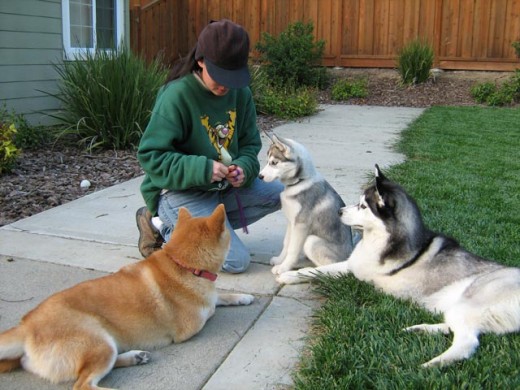
Calm a Dog to Noise

For a dog that is fearful or over-excited of loud noises such as fireworks or thunderstorms, the trigger stimulus is the noise. Therefore, our noise desensitization session would go something like this –
- We get a recording of fireworks or a thunderstorm and then play it (in loop mode) on our stereo at a very low volume. Make sure that the initial volume is low enough that our dog is able to stay calm.
- We engage our dog in focus and obedience exercises while the recording is playing and reward him well for staying calm and following commands.
- If everything is well, we increase the volume of our recording slightly and repeat step 2.
- If our dog stops accepting treats, or is no longer able to focus then we have moved forward too quickly. At this point we want to lower our volume by a few notches. Once our dog is calm again, we can repeat step 2.
- It is important to keep desensitization sessions short, positive, and rewarding. In this way, our dog will start to associate fireworks and thunderstorms with positive experiences rather than something that is threatening and stressful.
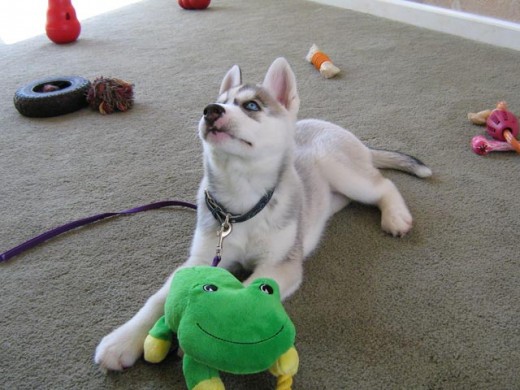
Calm a Dog to People

Dogs may also become anxious or over-excited when people come into their space and pet or hug them. Dogs are not humans, and they do not have the same communication cues as we do. When meeting a new dog, especially a shy dog, it is best to first ignore the dog and let him approach us.
We can help our dog become less fearful of people by desensitizing him using distance, focus, and rewards –
- Ask a friend to sit under a tree in our backyard and read a book.
- Meanwhile, we have our dog on-leash and stand far enough away from our friend that our dog is calm and relaxed.
- We get our dog’s focus and do some simple obedience exercises. He gets rewarded for staying calm and working together with us.
- If all is well, we move one step toward our friend and repeat step 3.
- It is important that our friend totally ignores the dog, which means no talking and no eye-contact. Eye-contact can be seen as an invitation to interact, or as a threat, especially by a shy dog. Either way, it can trigger an excited or fearful response.

As always, we want to keep desensitization sessions short, fun, and rewarding. In this way, our dog will learn to re-associate people with calmness and positive experiences.
- After several sessions, we may get close enough to our friend that she can throw some high priority treats to our dog. However, it is still important not to initiate eye-contact.
- If our dog is calm and does not have a bite history, we can let him come over and sniff our friend (still no eye-contact).
- Once our dog is comfortable with the scent of our friend and is calm, then we can bring her back a few paces and repeat the desensitization exercise with brief periods of eye contact.

In later stages we can repeat the desensitization process for –
- A person who is moving slowly.
- A person wearing unusually clothing, big hats, or carrying an umbrella.
- A person on a skateboard or bicycle.
- A person who is talking softly.
- A person who is talking in a high-pitched tone.
- A threatening person who is talking loudly.
The more things we desensitize our dog to, the more confident he will become and the more prepared he will be to handle new experiences.
However, patience is extremely important. The key to the desensitization process is to help dogs re-associate previously stressful or highly emotional situations with something calm and positive. Going too fast can scare our dog and cause him to become even more reactive of people.
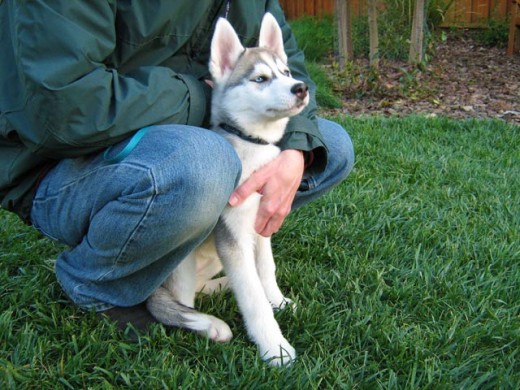
Calm a Dog to Confinement

Some dogs may get reactive when they are first confined in a crate. Confinement can be stressful because the dog loses his ability to escape if a threat should arise.
Before confining a dog in a crate for any length of time, it is best to first get the dog calm and desensitized to the crate.
- We start by showing the crate to our dog and letting him smell and examine it.
- Next we put some food near the entrance of the crate and let our dog step in to eat it.
- When he is comfortable with that, we throw some food deeper into the crate.
- We continue until our dog is cheerfully going into the crate on his own. At this point, make sure to leave the crate door open so our dog can move into and out of the crate freely.
- Once our dog is calmly moving into and out of the crate, we can close the door briefly. Wait one second, and then open the door again.
Finally, we slowly lengthen the time that our dog spends in the crate.
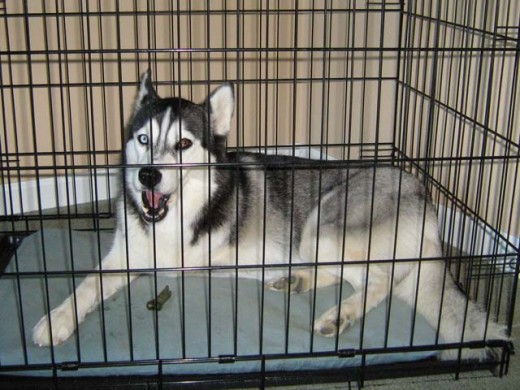
Desensitization vs. Flooding
In addition to desensitization, there is another technique called flooding that can also be used to deal with dog anxieties and fears.
With desensitization we expose a dog slowly to low amounts of the fear stimulus. We get the dog comfortable with the low level stimulus, then gradually train him to accept greater levels.
Flooding, on the other hand, exposes a dog to large amounts of the fear stimulus right away. The dog is then forced to experience the fear stimulus until he calms down.
Like us, a dog’s body can only keep pumping adrenalin for a fixed amount of time, i.e. there is a time limit to a dog’s fear response or panic attack. Theoretically, both human and dog will calm down after some time, realize that there is nothing to fear, and start to associate that new feeling of ease with the previously fearful stimulus.
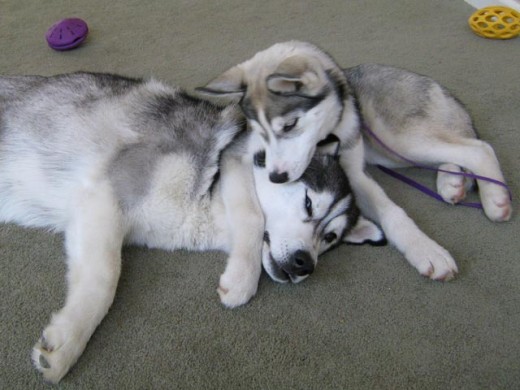
Flooding may be faster than the desensitization process, but it is risky, more traumatic, and may cause the dog to just shut down and stop responding.
Flooding is a psychotherapeutic method for overcoming phobias. This is a faster, yet less efficient and more traumatic, method of ridding fears when compared with systematic desensitization.
~~[Wikipedia]
For this reason, most animal behaviorists recommend using desensitization and counter conditioning methods to treat dog anxieties and fears. Desensitization may take more patience and more time, but it is safer, the results are long-lasting, and it helps to build a strong bond between us and our dog that is based on trust and respect.
The key to everything is patience. You get the chicken by hatching the egg, not by smashing it.
~~[Arnold H. Glasgow]

tip with travel crates that can dissemble into two halves… I start with the bottom half , make my dog LOVE to rest there. to the point where thats his fave spot, all love affection treats food etc given here . then keep the top half on it . and follow everything mentioned above . I have desensitized her to the door separately and only then attached it .. BUt then I have a highly sensitive and fearful dog , and I had to prepare her for a 30 hour flight across the world in the crate . BUt it worked great . On the day of the journey she was a happy dog in her crate .poor thing thought something great was going to happen because she got into the crate.
hi ther its joseph again,i 4got 2 mention our main concern..which is th main reason I looked 4 this type of site..maya seems 2 b a dog where she does not like getting told wot 2 do..whether its telling her 2 get down off th sofa or goin in2 th kitchen or any scenario wotsoever..she seems 2 stand her ground with u..an if u try getting a lil bit more firm with her she is reacting 2 us with a growl..as yet she hasn’t snapped apart from th cage incident I mentioned in my 1st message..is this in her breed or in ure opinion do u think this is a concern cos we really don’t wanna giv up on her..we have tried so so hard 2 make her feel part of our family..we believe we r doin everythin rite by her..with 2 young kids in th house aged 3 and 5 its obviously a concern..wot do u advise 4 us 2 try cos we can clearly see its not gonna b easy
hi there,we bought an 15month old female husky called maya 6days ago..1st night was absolutely fine her nature an everything seemed so lovely..but over the last few days as we r getting 2 have a better feel 4 her..we can tell she is so protective over her food 2 th stage it causing a bit of concern with us as we have 2 young kids at home..also th people that we bought her from were using a crate at nite an we can so tell this is a serious issue 2 maya..when bed time arrives her full attitude changes..she begins 2 pace an will point blank refuse 2 go in2 th crate..on th 2nd nite of her bein here as I was temting her in2 th crate she bcame very aggressive 2wards me an snapped out at me very badly..i gave her a minute 2 calm down then opened her crate I sat on th kitchen floor an she came rite out th cage an happily bounced all over me in a very playful manner its like she was thankin me 4 letting her out of th crate..we don’t want 2 give up on her as we have already seen so many lovely positive things bout her..just lookin 4 a bit of advice on th food issue an th crate..wot is th best way forward with these issues..many thanks..joseph…
Hello Joseph,
Given that there are young children in the household, I would get help from a good professional trainer. Dog behavior is very context dependent, and meeting with a trained professional who could observe and assess my dog, helped me a lot, especially in the beginning.
http://www.apdt.co.uk/dog-owners/choosing-a-trainer
More on my food aggression experiences with my dogs-
http://shibashake.com/dog/stop-food-aggression-stop-resource-guarding
http://shibashake.com/dog/why-dogs-get-aggressive-over-food-toys
http://shibashake.com/dog/resource-guarding-shiba-inu
More on what I do to crate train my dog.
Crate training article from the ASPCA.
More on pack leadership-
http://shibashake.com/dog/pack-leader-to-an-aggressive-dog
http://shibashake.com/dog/nothing-in-life-is-free-dog-training
More on how dogs learn.
Big hugs to Maya. Let us know how it goes.
nah sadly i dont do the whole facebook thing soi dont have any pictures maybe my sister does on her facebook but giving that out wouldnt be looked upon kindly im sure
hes a tan/light brown coloured west highland terrier/pomeranian mix
you can see the westie head/hairstyle on him and hes got the pom bushy tail but his body is quite well defined and not bushy at all
Thanks for the description. Alfie certainly sounds like a very unique and special character!
If you decide to get on FB in the future, make sure to post us a link.
well, judging by the dates im almost a month in(since we only meet rosie behind the fence 2-3 days a week) and a week or so ago the excitement barking has all but stopped. there are situations where it starts again but those are understandable
(although still unwanted) circumstances, i.e. walking out around a parked car which is where he would usually get within sight of rosie and when we are around the car he gets a face full of rosie 2-3 feet away
another thing that surprised me was that one time coming in from the walk last week we were sitting across the road from rosie and her fence(6-8 feet away) and rosie started barking first so i thought here it comes, to my surprise i held alfies attention for a good 45-60 seconds of rosie barking before rosies owner took her inside(theres a sick person living next door to rosie so too much barking is def a bad thing so her owner takes rosie in and you cant blame people for that either)
even though we had got closer on quite a few occasions it was the fact that i was able to hold alfies attention while rosie was barking away behind the fence that i felt was a huge breakthrough
anyway just wanted to leave an update, thanks for all the help and advice, everythings been super helpful
It is awesome that Alfie is doing so well!
Do you have pictures of him online? It would be great to attach a face to the stories. 😀
Thanks for the update. Happy dog stories are the best.
yeah he has his standard doggy chocolate buttons for treats but during the stop/go walking ive been using a chicken and ham roll(trying to translate into american, from memory i guess it would be a cold cut of meat? idk) that he really loves and yesterday i took him in around a small field and let him sniff around as much as he wanted without prompting him to move on so hes living the high life atm. sadly theres no dog parks or parks in general around here(small-medium town, less than 100k people)
with other dogs he doesnt seem to lose control, none of the dog owners weve met during our walks have stopped to let the dogs get to know each other so its just passing engagements for alfie except for the time we met rosie out for a walk and all they did was sniff at each other so i cant say whether or not he would have lost control if he/they barked, alfie at least did seem to be, i want to say shaking with excitement but i dont think shaking is the right word, he seemed a little jittery i guess would be closer to the truth but that might just be left over nerves from their past encounters
while i cant say for sure, i think its rosies barking hes reacting to rather than the fence, im not saying shes totally to blame as if we just walk straight past the front garden where rosie is usually without me stopping to try and condition alfie he will sometimes be the initiator but for today at least it was rosie that initiated as he didnt lose control until rosie started barking because of the car passing today, which come to think of it rosie does a lot, even before i started walking alfie(i was quite lazy but alfie is helping me with that) when passing in the car she would always bark.
its not just loud noises either that hes reacting to as today while out for his walk a bin lorry passed us on the same side of the road that we were on the footpath(sidewalk) and we pass a construction site with a digger working and it didnt even phase him a little, he just kept walking with no signs of pulling back or of him being startled or making any attempt to bark
ok after reading the two barrier frustration links you posted i dont think this describes alfie at least, yes alfie barks at other dogs when hes at the side fence(it looks out onto our driveway and so the front of our house) but its a very narrow view so he may think this is just his territory and most of the neighbourhood dogs are off lead and seem to bark at anything. as far as other neighbourhood dogs go im fairly sure they initiate the barking too but alfie seems happy enough to join in but again its not out of control barking and he usually stops when prompted to do so, it may take a few times depending on how many dogs are barking but he always stops
i will have to pay more attention while out walking but from memory i think most of the time the barking isnt initiated by him and aside from the first monday night of obedience training(only two so far) he hasnt had any problems with the other 8-9 dogs there and they are all on leads, they said itll be week 7-8 before we do off lead stuff. the other dogs at the training vary in size from adult saint bernards to young adolescent terriers
ill have to monitor him more closely over the next few walks/days as if it is just the sound of a barking dog thats triggering him then ill start working on noise desensitization as soon as i know one way or the other, it should be easy enough to download barking noises to get us started and hopefully with this and the other desensitization to the general area of rosies house/garden we can be on our way to more enjoyable and relaxed walks
thanks again for the help, i havent been through your whole back catalogue of posts yet but give me time 😀
hey again, first day trying solo desensitization(well first day where rosie was actually out in the front garden) and it went quite well. i got alfie to about half the distance compared to where he usually loses control and he only then lost control because a car passed by and startled rosie, she started barking which set alfie off and i thought it was a good point to call it a day. all in all it was a good day. i find myself stopping a lot less to keep alfie from pulling on the lead so thats going great too, great site man, really a lot of useful and helpful info, thanks
That is great to hear! Alfie definitely deserves something special for acing his lessons. 😀
Yeah, I have the same experience with my dogs, usually when they see running squirrels or deer. 😀 When they go rear-brained and instinct takes over, I usually just remove them from the trigger stimulus, and get them to a quiet area where they can calm down. After instinct takes over, they are lost to me and can no longer learn until they calm down (i.e. conditioning will have little/no effect until they calm down).
Fences can cause this behavior because of barrier frustration. Another interesting article on barrier frustration. However, from your descriptions, it is unclear if Alfie is reacting to the fence or Rosie’s barking. How does Alfie react to other barking dogs? If Rosie is outside the fence and barking, does Alfie react to that?
For dogs that are reactive to barking sounds, doing noise desensitization exercises may also help.
To stop barking with my dog, I usually start by identifying the reason for his barking behavior. Once I understand that, I can more effectively address the issue at the source, rather than just suppressing the symptoms.
Here is a bit more on how I stop my dogs from barking.
hey again, as i was thinking just now i think i got what you were saying
i should treat it as two separate situations,
1 the excitement barking i should treat with desensitizing him to rosie as they meet through the fence(the only time it happens)
2 normal barking which treated with the collar jerk works fine
the collar jerk works fine when he doesnt get excited, its when he does get too excited that i feel that the collar jerking gets to excessive because it can last anywhere between 30-90 seconds, it doesnt sound a lot but when you take a jerk every 2-3 seconds it could cause serious damage which is what i was worried about and my reason for posting
so your saying by using the two at the same time im being counter productive?
the collar jerk does work in certain situations its just that when he(i know this is the wrong way to say this because of negative implications but) loses control its like he doesnt hear me until i get him calmed down but then does that mean i shouldnt use the collar jerk during this period. i use a treat and positive rewards when he calms down to try and tell him that its good to be calm but whatever is going on in his “animal” brain just shuts down his ability to accept/hear commands when he gets that excited. i know he can learn commands/conditioning quickly as i tried the stop/go method of getting him to not lead pull yesterday during out walk and halfway through i noticed a huge difference in him not pulling the lead, the only difficulty i had in doing that was that i had to distinguish between him walking at the edge of the lead(leash) and him actually pulling on the lead.
as i said before he doesnt have a problem with the dog when meeting face to face as we met on a walk a few days ago and while there was a little barking i collar jerked a few times(not more than 5-10 seconds) and it was gone, just sniffing for the other 30 or so seconds we were talking but once again while a fence between them they go ballistic and it can be a good 30 seconds before he calms down
i think im going to try the desensitization alone for a few days/week, it may take longer because itll be him calming down naturally but ill give it a go
with him losing his ability to take commands when he gets that excitied would there be any point in turning around 180o and walking a shot distance back and trying to employ that? as surely the “barking gets you nowhere” routine would be(to use an american idiom” in the same ballpark
ofc the problem with that in my situation is that most dogs in our estate are off leash and get to run around freely so they havent built the best of relationships with alfie as he sees them out the front window and they are sometimes in his garden(he gets the run of the back garden for most of the day as there is no gate securing the front driveway)
hey there, what would you suggest for my dog alfie, hes a small terrier type who seems to only have a problem with one dog. where i live there is only one exit(from the estate of houses(i live in uk so sorry if the differences in terms causes a barrier) and at the end house there is another small dog(rosie) and when they are face to face no barking at all happens, i know this because they met each other just today during their respective walks but when i pass the house where rosie resides and there is a fence between them they go ballistic, im not sure you could determine which of them is the initiator but when there is a fence between them its crazy. alfie gets so worked up its almost like you described in the squirrel articles, he doesnt hear my commands at all, all of which he responds to perfectly in the twice daily 15-30 min sessions . we have been going to obedience training(for the last 2 mondays and will continue) and they say that a collar jerk will work, ive been out 5-6 times trying the collar jerk but im worried about hurting him as just today he seemed to almost whelp instead of bark near the end of getting him to calm down. the 4th time i had him out(since training started) i sort of figured out Desensitization by trail and error, i use collar jerk to calm him down then when he stops i treat and pat him, command him to sit and when he does i then again treat and pat him, move him forward some and repeat, the problem with this has been that the owner of the other dog while perfectly ok with alfie brings her dog in from the front yard so i only get within 8-10ft of rosie before this happens, i cant fault her for this as im sure its a stressfull situation for both dogs as rosie is 4-5 years old but im sure it does stunt alfies training. after last weeks obedience training the dog trainer suggested using a squirty water bottle which i have started using today so hopefully that will make a difference.
with the collar jerk i have seen an improvement but since alfie is at the extent of the lead when he needs to be jerked it leans more toward choking for the first few seconds
any advice?
Hello Stephen,
The leash or collar correction is actually an aversive conditioning technique which suppresses behavior through the use of an aversive stimulus. Here is a bit more on my experiences with collar corrections. The squirt bottle is also an aversive conditioning technique.
Desensitization and counter conditioning is a very different process. In the desensitization process, we first start with a very weak version of the ‘other-dog’ stimulus, weak enough that our dog is able to stay calm and focus on us. For example, we can weaken the ‘other-dog’ stimulus by using distance.
At the start, I have Sephy (my Shiba Inu) on-leash, and we stand far enough away from the other dog, that Sephy is able to stay calm and listen to commands. Then, I do some simple commands with him and reward him well for staying calm and working with me. This teaches him to ignore the other dog, to focus on me, and to Sit instead of lunge and bark. Once we are comfortable doing this, I move one step closer to the other dog and repeat the process.
Note that with desensitization/counter-conditioning, we use positive rewards and *not* an aversive correction. This is very important because the rewards help Sephy to reassociate other dogs with positive events and it also helps to build trust with me. The more successful sessions we have, the more confident Sephy becomes, the more he trusts me, and the more he views other dogs in a positive way.
Here is more on dog-to-dog desensitization.